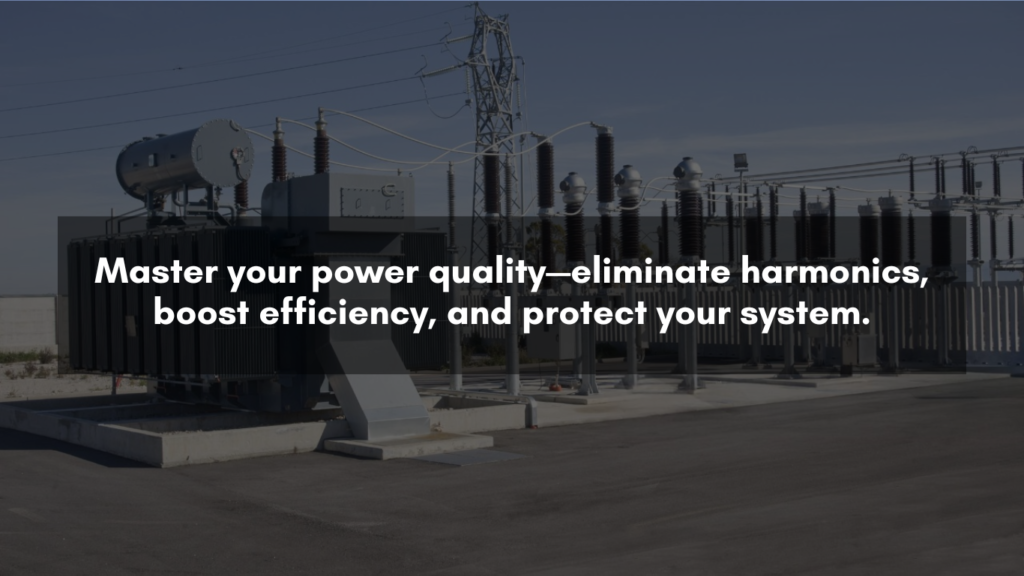
Harmonics are unwanted distortions or multiples of the fundamental frequency present in electrical power systems. These distortions are caused by nonlinear loads such as electronic devices, power converters, and arc furnaces. Harmonics can lead to a range of issues including equipment overheating, voltage distortion, and interference with communication systems.
Why Harmonic Analysis Required?
Harmonic analysis is essential for assessing and mitigating the impact of harmonics on power systems. By conducting harmonic analysis, engineers can:
- Identify harmonic sources and their effects on the system.
- Ensure compliance with international standards and regulations.
- Optimize system performance and reliability.
- Prevent equipment damage and downtime.
Steps Involved In Harmonic Analysis
we utilize state-of-the-art software tools like ETAP (Electrical Transient Analyzer Program) to perform comprehensive harmonic analysis. Our methodologies include:
- Data Collection: Gathering relevant information about the power system, including load profiles, equipment specifications, and operating conditions.
- Simulation: Using ETAP to simulate harmonic currents and voltages, analyze system performance, and identify potential issues.
- Harmonic Load Flow Studies: Evaluating the flow of harmonic currents and voltages throughout the system to assess their impact on equipment and voltage levels.
- Resonance Analysis: Identifying resonance conditions where harmonic frequencies interact with system impedance, leading to voltage amplification and potential equipment damage.
- Mitigation Strategies: Recommending and implementing mitigation measures such as harmonic filters, load management techniques, and harmonic-resistant equipment.
Outcome Of The Harmonic Analysis
- Harmonic Analysis Report
- Summary of Analysis: An overview of the objectives, methodologies, and scope of the harmonic analysis conducted using ETAP.
- Harmonic Profiles: Presentation of harmonic voltage and current waveforms, including magnitudes and frequencies of harmonic components.
- Harmonic Distortion Assessment: Evaluation of harmonic distortion levels relative to industry standards and guidelines (e.g., IEEE 519, IEC 61000).
- Identification of Harmonic Sources: Analysis of the main contributors to harmonic distortion within the power system, such as nonlinear loads or power electronic devices.
- Voltage and Current Total Harmonic Distortion (THD) Analysis: Calculation and comparison of THD levels at various points in the system.
- Resonance Analysis: Assessment of resonance conditions and potential risks associated with harmonic interaction with system impedance.
- Harmonic Load Flow Studies: Analysis of harmonic currents and voltages flow throughout the system, identifying areas of concern or potential equipment overload.
- Mitigation Recommendations: Recommendations for mitigating harmonic distortion, including the implementation of filters, load management strategies, or harmonic-resistant equipment.
- Compliance Assessment: Verification of compliance with relevant industry standards and regulations governing harmonic distortion levels.
2. Simulation Results and Data
- ETAP Simulation Files: Providing the ETAP project files used for the harmonic analysis, enabling the client to review and validate the simulation results.
- Raw Data: Furnishing raw data collected during the analysis process, including load profiles, equipment specifications, and operating conditions.
3. Visualization Tools
- Graphs and Charts: Visual representation of harmonic waveforms, frequency spectra, and voltage/current profiles to facilitate understanding and interpretation of the analysis results.
- Interactive Plots: Interactive visualizations allowing clients to explore harmonic data and simulation results in detail.
4. Executive Summary and Recommendations
- Executive Summary: A concise summary highlighting the key findings, critical issues, and recommendations derived from the harmonic analysis.
- Actionable Recommendations: Clear and actionable recommendations for addressing identified harmonic issues, optimizing system performance, and ensuring compliance with standards.
5. Technical Support and Follow-up
- Expert Consultation: Availability of technical experts to provide clarification, answer questions, and offer guidance on implementing recommended mitigation measures.
- Follow-up Services: Ongoing support to monitor system performance, assess the effectiveness of implemented solutions, and address any emerging issues.
REFERENCE STANDARDS
Reference standards are essential guidelines that ensure your power system’s harmonic levels meet industry requirements. We adhere to globally recognized standards like
- IEEE 519
- IEC 61000 Series
Find out more about how we can help with ESG
